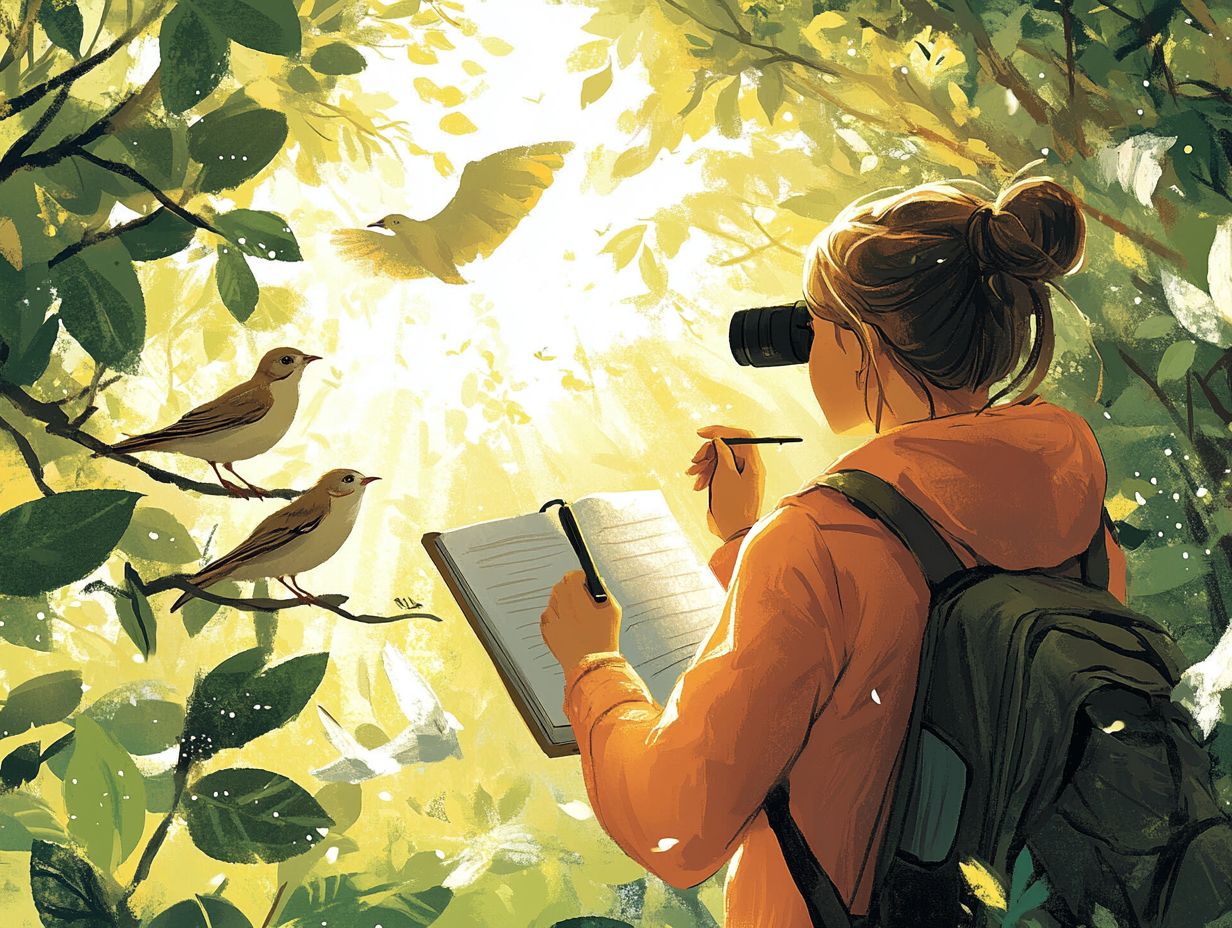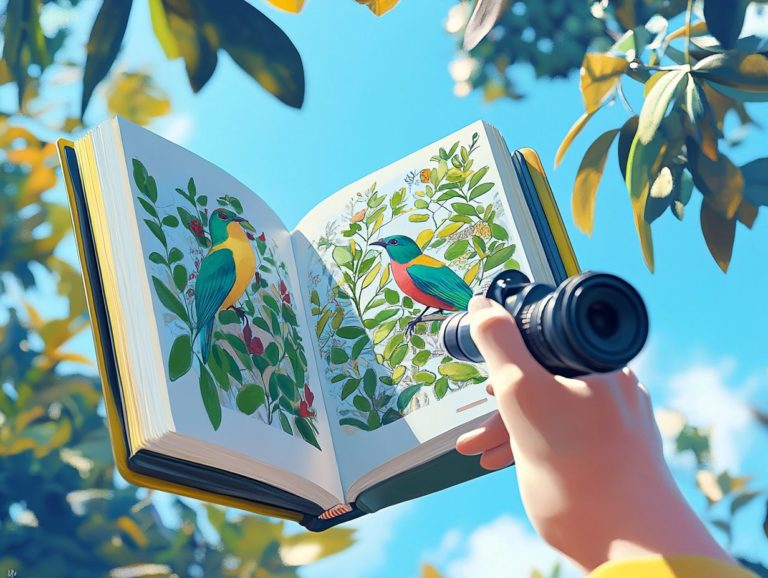How to Read Bird Behavior While Watching?
Understanding bird behavior reveals captivating insights into the lives of these remarkable creatures and helps you learn how to identify birds in your surroundings.
From the subtle signals of courtship to the frantic flapping of alarmed birds, each action unfolds a story just waiting for you to decipher.
This guide will equip you with the basics of birdwatching, highlighting best practices for observing them in their natural habitats, interpreting common behaviors such as vocalizations and communication, and selecting the right tools for a successful outing.
You ll also discover how to document your observations and contribute to citizen science, allowing you to make a meaningful impact on avian research.
Dive in as you explore the enchanting world of birds!
Contents
- Key Takeaways:
- Understanding Bird Behavior
- Observing Birds in Their Natural Habitat
- Interpreting Bird Behavior
- Tools for Bird Watching
- Recording and Documenting Bird Behavior
- Contributing to Citizen Science
- Frequently Asked Questions
- What is bird behavior and why is it important to understand while watching?
- How can I determine a bird’s species based on its behavior?
- What are some common bird behaviors to look for while watching?
- How can I tell if a bird is distressed or in danger?
- What should I do if I observe aggressive behavior between birds?
- Can bird behavior change over time?
Key Takeaways:

- Pay attention to the surroundings and body language signals of birds to understand their behavior and emotions.
- Use binoculars and cameras to observe birds from a safe distance and document their behavior.
- Keep a birding journal and contribute to citizen science by reporting your observations.
Understanding Bird Behavior
Understanding bird behavior is essential for you as a birdwatcher looking to elevate your birdwatching experience. Observing species like robins, mocking jays, and woodpeckers can provide you with invaluable insights into their appearance, distinctive behaviors, and feeding habits.
By honing in on visual cues and the nuances of various bird expressions, you can identify these feathered wonders more effectively and appreciate the intricate interactions within their environment.
Why is it Important?
Understanding the significance of observing bird behavior is crucial for you as a birdwatcher to refine your skills in identifying various species in their natural habitats.
By paying close attention to the subtleties of avian actions like their unique communication styles and distinct feeding habits you can pick up on the differences that set species apart. For example, a bird’s song can reveal not only its identity but also its emotional state or readiness to mate.
Observing feeding patterns, such as foraging techniques and social dynamics at a food source, provides vital clues that enrich your birdwatching experience.
These behaviors deepen your connection to individual species and shed light on broader ecological relationships, illustrating the intricate balance within ecosystems. Recognizing these elements will significantly enhance your appreciation for avifauna (bird species) and the environments they call home.
Observing Birds in Their Natural Habitat
Observing birds in their natural habitat presents you with a distinctive opportunity to witness their behaviors and interactions up close. This experience not only enhances your birdwatching journey but also provides invaluable insights for identifying various species.
Best Practices for Watching Birds
To truly elevate your birdwatching experience, it’s essential to embrace best practices that sharpen your ability to observe bird behaviors.
Selecting the right location is fundamental; seek out areas abundant in vegetation, near water sources, or designated parks, as these spots are typically bustling with avian life.
The time of day also plays a pivotal role in your observations, with early mornings and late afternoons generally being the most active periods for many species.
Equipping yourself with quality binoculars, a reliable field guide, and perhaps a notebook for jotting down your sightings can make an extraordinary difference.
Grasp visual cues such as color patterns, distinct flight patterns, and body posture to differentiate between similar species with ease.
Interpreting Bird Behavior

Interpreting bird behavior is an invaluable skill for you as a birdwatcher. It grants you a deeper insight into their actions, emotions, and interactions within their environment. For more information, check out understanding bird behavior with field guides, enriching your overall experience and appreciation for these magnificent creatures.
Start your birdwatching journey today and share your experiences!
Common Behaviors and What They Mean
Bird behaviors, like feeding patterns and vocalizations, give you insight into their social connections and emotional states. For instance, beak clicking and tail wagging reveal a lot about how they feel.
Take ground foraging, for example! You often see species like sparrows and pigeons scouring the dirt and vegetation for seeds and insects. This behavior is more than just feeding it s a social event! When they forage in groups, it allows them to establish and reinforce social hierarchies.
Then there s beak clicking, a delightful sound you might hear from species like the Cockatoo. This form of communication conveys excitement or contentment, strengthening the bonds within their flocks.
These specific behaviors reveal the nuanced ways birds interact with one another and their environments, showcasing the complexity of their social lives.
Tools for Bird Watching
The right tools can elevate your birdwatching experience! High-quality binoculars and cameras let you observe and document various species in breathtaking detail.
Binoculars, Cameras, and Other Equipment
High-quality binoculars and cameras are essential tools for your birdwatching adventures. They enhance your ability to observe and document the fascinating behaviors and characteristics of our feathered friends.
Choose binoculars with a wide field of view and high magnification. These features help you track fast-moving birds easily. Top brands for binoculars often include features like waterproofing and anti-fog coatings, ensuring that outdoor observation remains pleasant regardless of the weather.
For photography, a camera equipped with a solid zoom lens allows you to capture stunning detail in distant subjects. A quick autofocus feature ensures you don t miss those fleeting moments. Don t overlook accessories like stabilizing tripods or lightweight camera straps; they can significantly enhance your experience, providing steady shots and reducing fatigue during those long hours in the field.
For an added layer of enjoyment, consider bringing along a field notebook or utilizing apps designed for bird identification. These tools can truly enrich your observation process, making each outing more informative and rewarding.
Recording and Documenting Bird Behavior
Recording bird behavior is key to successful birdwatching. It helps you track your observations and assist in species identification.
Keeping a Birding Journal

A birding journal is your trusty companion! Use it to document your sightings, behaviors, and experiences.
By diligently recording crucial details such as the date and specific location of each sighting, you can track seasonal patterns and migratory behaviors that may influence which species are present. Add notes on the species you’ve observed, along with remarkable behaviors like feeding habits, mating displays, or interactions with other animals to foster a deeper understanding of avian life.
When you take the time to reflect on your entries, you engage in a rich learning process. This sharpens your identification skills and nurtures a greater appreciation for biodiversity. Over time, this practice not only elevates your personal experience but also contributes to a broader awareness of ecological changes.
Contributing to Citizen Science
Join citizen science initiatives! Share your observations to help researchers gather invaluable data on bird populations.
Your contributions play a crucial role in enhancing our understanding of avian life and the various species’ unique behaviors.
How to Report Your Observations
Ready to make a difference? Reporting your observations is an easy way to participate in citizen science, allowing you to contribute meaningfully to expansive ecological research!
By carefully recording details of each sighting, you provide valuable data that deepens our understanding of bird behaviors and populations. Start by noting the date, time, and location of your observations. These specifics are crucial for researchers trying to identify patterns and shifts in species distribution, or how different types of birds are spread out in various areas.
Utilize notebooks or specialized digital apps tailored for birdwatching, which make data entry and retrieval effortless. Keep a field guide handy to aid in accurate species identification, and jot down any unique behaviors or environmental conditions that might influence your sightings.
By paying attention to details, you enrich your knowledge and make your contributions reliable and impactful.
Frequently Asked Questions
What is bird behavior and why is it important to understand while watching?
Bird behavior refers to the actions and movements of birds, which can provide valuable insights into their habits and needs. Understanding bird behavior while watching allows for a more enjoyable and educational bird-watching experience.
How can I determine a bird’s species based on its behavior?

By observing a bird’s behavior, such as its flight pattern, foraging techniques, and vocalizations, you can make an educated guess about its species. Reference guides and online resources can also help to identify a bird based on its behavior.
What are some common bird behaviors to look for while watching?
What are some common bird behaviors to look for? Some include feeding, nesting, courtship, and flight patterns! Paying attention to these behaviors can provide insights into the bird’s daily routine and overall well-being.
How can I tell if a bird is distressed or in danger?
A bird’s behavior can indicate distress or danger, such as a sudden change in flight pattern, loud vocalizations, or fluffed feathers. If you notice any of these behaviors, it is best to keep your distance and avoid disturbing the bird.
What should I do if I observe aggressive behavior between birds?
If you witness aggressive behavior between birds, it is best to give them space and not intervene. This behavior is often a natural part of their social hierarchy and should be allowed to play out without human interference.
Can bird behavior change over time?
Yes, bird behavior can change over time due to various factors such as environmental changes, mating season, and food availability. It is essential to observe birds regularly to track any changes in their behavior patterns.
So, are you ready to start your birdwatching journey today? Join us in making a real impact!





